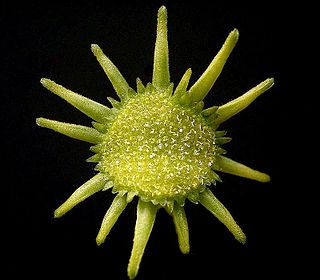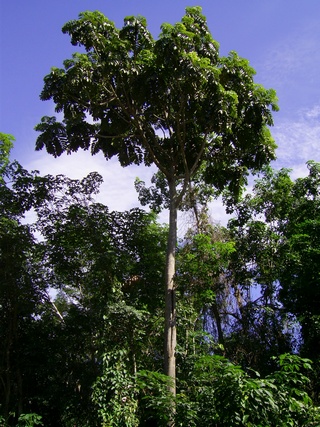
Breadfruit is a species of flowering tree in the mulberry and jackfruit family (Moraceae) believed to be a domesticated descendant of Artocarpus camansi originating in New Guinea, the Maluku Islands, and the Philippines. It was initially spread to Oceania via the Austronesian expansion. It was further spread to other tropical regions of the world during the Colonial Era. British and French navigators introduced a few Polynesian seedless varieties to Caribbean islands during the late 18th century. Today it is grown in some 90 countries throughout South and Southeast Asia, the Pacific Ocean, the Caribbean, Central America and Africa. Its name is derived from the texture of the moderately ripe fruit when cooked, similar to freshly baked bread and having a potato-like flavor.

The Moraceae—often called the mulberry family or fig family—are a family of flowering plants comprising about 38 genera and over 1100 species. Most are widespread in tropical and subtropical regions, less so in temperate climates; however, their distribution is cosmopolitan overall. The only synapomorphy within the Moraceae is presence of laticifers and milky sap in all parenchymatous tissues, but generally useful field characters include two carpels sometimes with one reduced, compound inconspicuous flowers, and compound fruits. The family includes well-known plants such as the fig, banyan, breadfruit, jackfruit, mulberry, and Osage orange. The 'flowers' of Moraceae are often pseudanthia.

Artocarpus integer, commonly known as chempedak or cempedak, is a species of tree in the family Moraceae, in the same genus as breadfruit and jackfruit. It is native to Southeast Asia. Cempedak is an important crop in Malaysia and is also popularly cultivated in southern Thailand and parts of Indonesia, and has the potential to be utilized in other areas. It is currently limited in range to Southeast Asia, with some trees in Australia and Hawaii.

Artocarpus is a genus of approximately 60 trees and shrubs of Southeast Asian and Pacific origin, belonging to the mulberry family, Moraceae. Most species of Artocarpus are restricted to Southeast Asia; a few cultivated species are more widely distributed, especially A. altilis (breadfruit) and A. heterophyllus (jackfruit), which are cultivated throughout the tropics.

Artocarpus odoratissimus is a species of flowering plant in the Moraceae family. It is a commonly called marang, madang, timadang, terap, tarap, kiran, green pedalai, or johey oak. It is native to Borneo, Palawan, and Mindanao Island, and is closely related to the jackfruit, cempedak, and breadfruit trees which all belong to the same genus, Artocarpus.
Artocarpus blancoi is a species of large tree in the family Moraceae endemic to the Philippines. Its habitat is threatened.

Sorocea is a Neotropical genus of woody plants in the family Moraceae. Its distribution ranges from Chiapas to southern Brazil. It is placed within the tribe Moreae, and is closely related to the monotypic Bagassa.

Treculia is a genus of trees in the plant family Moraceae that is native to west and central Africa and Madagascar. The best-known member of the genus, Treculia africana, commonly known as the African breadfruit, is used as a food plant.

Moreae is a tribe within the plant family Moraceae. It includes 6–10 genera and 70–80 species, including Morus, the genus that includes the mulberries, and Maclura, the genus that includes the Osage orange.

The Castilleae are a tribe within the plant family Moraceae. It includes eight to 11 genera and 55–60 species including Castilla, the Panama rubber tree.

Dorstenia is a genus within the mulberry family, Moraceae. Depending on the author, there are said to be 100 to 170 species within this genus, second only in number to the genus Ficus within Moraceae. Plants of the World Online currently accepts 122 species. Dorstenia species are mainly known for their unusual inflorescences and growth habits. Dorstenia is named in honor of the German physician and botanist Theodor Dorsten (1492–1552). The type species is Dorstenia contrajerva.

Artocarpus anisophyllus, the entawak or mentawa, is a tropical tree in the Moraceae. It is native to the central parts of Southeast Asia, and is present in Peninsular Malaysia, Sumatra, Borneo and the intervening islands. It is called popwan in Palawan, Philippines.

Artocarpus camansi, the breadnut, is a species of medium-sized tree in the family Moraceae. It is native to New Guinea, the Maluku Islands, and the Philippines. It is the wild ancestor of the breadfruit (Artocarpus altilis) and is also sometimes known as the seeded breadfruit, to distinguish it from its mostly seedless descendant. Breadnut fruits are edible when cooked. The large seeds can also be roasted and eaten.

Glyphodes caesalis is a moth in the family Crambidae. It was described by Francis Walker in 1859. It is found in Sri Lanka, mainland India, Myanmar, the Andaman Islands, New Guinea, Bangladesh, Fiji, Hong Kong, Thailand and Australia (Queensland).

One of the major human migration events was the maritime settlement of the islands of the Indo-Pacific by the Austronesian peoples, believed to have started from at least 5,500 to 4,000 BP. These migrations were accompanied by a set of domesticated, semi-domesticated, and commensal plants and animals transported via outrigger ships and catamarans that enabled early Austronesians to thrive in the islands of Maritime Southeast Asia, Near Oceania (Melanesia), Remote Oceania, Madagascar, and the Comoros Islands.

Artocarpus gomezianus is a tree in the family Moraceae and a wild species on the breadfruit/jackfruit genus (Artocarpus); it may be referred to as the 'sampang' and its Vietnamese name is mít chay. Distribution records are from: Assam, through Indo-China to west Malesia.

Artocarpus lamellosus is a tree species in the family Moraceae and a wild species of the breadfruit/jackfruit genus (Artocarpus); it may be referred to as the butong in Tagalog and its Vietnamese name is mít nhỏ. Distribution records are from China, Indo-China and Malesia through to New Guinea.

Characteres generum plantarum is a 1775/1776 book by Johann Reinhold Forster and Georg Forster about the botanical discoveries they made during the second voyage of James Cook.















